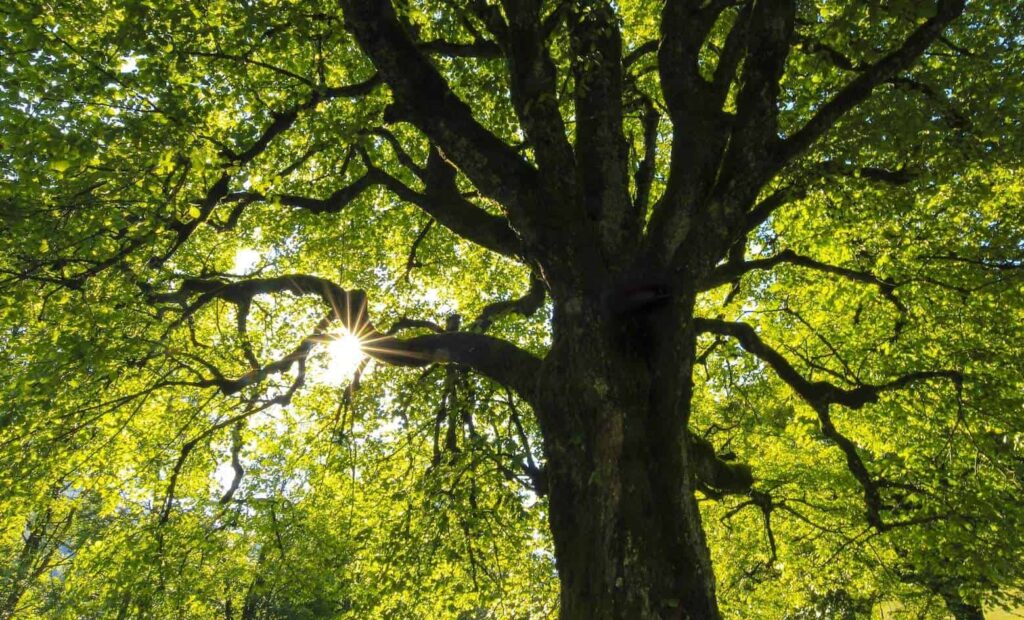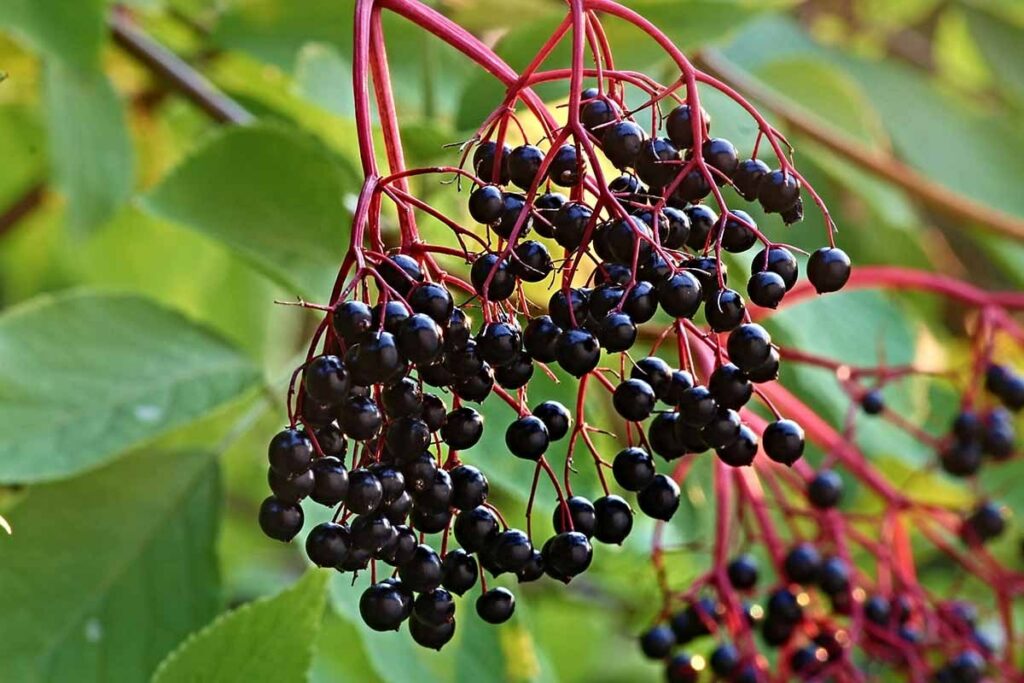
Roundup is well-known in the gardening world as a fast-acting weed killer. Recently, this herbicide has been racking up a reputation for being an effective tree killer, too.
Let’s explore how true this claim is. Read on to learn if Roundup can kill trees, how it works, and ways to effectively use it.
Will Roundup kill trees?
Roundup can kill trees, especially young and thin-barked ones, as its main active ingredient is glyphosate. This stops plant cell division, hindering protein production.
Since it’s absorbed by the roots and leaves, it can easily travel along the vascular system, killing all parts of the plant.
However, large, mature trees that have thicker barks are typically hardier. This makes them difficult to kill by just applying Roundup onto the canopy.
In this case, you’ll need to perform a couple of preparatory steps before using the herbicide to effectively kill it.
How does Roundup work?
Roundup works by recreating phosphoenolpyruvate (PEP), a natural compound that’s in charge of glycolysis, which, in large doses, inhibits EPSP synthase ( 5-enolpyruvylshikimate-3-phosphate).
ESPS synthase is an enzyme essential for many plant processes. Without it, plants can’t create amino acids and proteins, which are needed for proper growth and development.
Roundup is highly effective since it’s meant to be sprayed onto the plant’s foliage and roots. Once it’s absorbed, it makes its way into the sap stream, vascular system, and roots, affecting every part of the plant.
As a result, the plant will begin to have trouble with the uptake of nutrients. Coupled with the inability to produce EPSP synthase, the plant will gradually weaken and then die.
It’s important to remember that glyphosate is a non-selective herbicide. This means that it doesn’t discriminate against plants and will damage any that it comes into direct contact with.
Hence, you’ll want to use it carefully to avoid any casualties in your garden.
How much Roundup does it take to kill a tree?
The amount of Roundup required depends on your tree type, size, and age. Nevertheless, the more concentrated Roundup, the more effective.
Hence, you can use a smaller concentration percentage for smaller trees and higher ones for larger trees.
Even then, it’s important to keep in mind that the hardier your tree is, the more Roundup applications will be needed for it to die.
Apart from that, environmental conditions also play a role in how the herbicide affects your tree. For example, rainfall could cause the coat of Roundup to wash off before the tree has absorbed enough to cause significant harm.
It’s vital that you discern the herbicide’s effects on your tree. If it doesn’t appear to be working or showing any signs of damage after about 2 weeks, you’ll want to do the treatment again.
If your tree still won’t budge, you’ll want to raise the glyphosate concentration percentage. Observe your tree for about 7 to 14 days before reapplying.
How do I kill a tree with Roundup?
You can kill a tree with Roundup by using either the foliar spray method, which is usually for juvenile trees; or the spray injection technique and cut-stump method, which are great for large, mature trees.
But before that, you’ll want to look into whether using Roundup is permitted in your area. It’s interesting to note that Roundup is against the law in certain districts.
On top of that, be sure to wear protective personal equipment as you’ll be handling a chemical herbicide.
That said, don a mask, eye or face protection, gloves, and skin-covering clothing such as a long-sleeved shirt, pants, and closed-toed shoes.
Going back, let’s look at the step-by-step instructions on how you can do each method.
Foliar Spray Method
| Difficulty | Easy ●●○○○ |
| Speed | Fast-acting |
| Things You Need | Personal protective equipmentAluminum, plastic, or stainless steel backpack sprayer or spray bottleLadder (optional)Roundup |
The method is just what it sounds like – spraying the foliage of the tree you want to kill with a generous amount of Roundup.
This works best on trees that are young or have a thin bark as the herbicide can easily penetrate through.
Aside from that, the foliar spray method is easily done on trees that have quite a lot of leaves. This gives the herbicide a multitude of entry points, increasing effectiveness.
This technique is also ideal for trees that are quite tall. Using a ladder and backpack sprayer will give you enough leverage to cover hard-to-reach areas.
| How To Do First off, protect any nearby plants that you don’t want to kill. Remember that the main ingredient in Roundup is glyphosate, a non-selective herbicide that will damage any plant that it comes into contact with. Even the slightest contact with a sapling will cause it to be a goner. Hence, cover vulnerable plants with a protective plastic sheet, landscape plastic, ground cover, or similar materials. Prepare the Roundup herbicide as instructed by the label’s directions. More often than not, Roundup comes in a ready-to-use formula. However, there are a few variants that require dilution. Evenly coat the foliage of your tree, starting from the top of the canopy, carefully working your way downwards. Spray any exposed roots, too. Working from top to bottom ensures that there’s less wastage as the excess Roundup simply falls onto the foliage below. Be wary to not overdo your application. While full canopy coverage is ideal, you don’t want Roundup dripping from the leaves. While one generous coat should be enough, you can still add another for extra measure. Before doing so, make certain that the first layer is completely dry first. Keep an eye out for any signs that your tree is dying. You can tell that the Roundup is working if the foliage of your tree is yellowing, wilting, and thinning. If you applied the herbicide correctly, damage should be noticeable within the first 7 to 14 days. Constantly monitor the deterioration process of your tree. If it begins to show signs of regaining its health and perking up, then you should reapply the herbicide. Once your tree has died, remove it from the premises. If your dead tree is small enough to be chopped up into smaller pieces with a chainsaw and dug out, then you can choose to do it yourself. Don’t forget to yell, “timber” as it drops! Though if you’re not up for the manual labor or if your tree is just too big, you can call an arborist to get the job done for you. |
Stem Injection Technique
| Difficulty | Moderate – Hard ●●●●○ |
| Speed | Slow-acting |
| Things You Need | Personal protective equipmentPower drill, hatchet, or axDye (optional)RoundupHeavy-duty plastic sheet |
If you’ve got a thick, mature tree that you can’t simply cut down, then the stem injection technique is what’s going to work for you.
Since Roundup can’t easily penetrate through thick bark, you’ll have to make a 45-degree angle cut or hole several inches deep using a power drill, hatchet, or ax.
To increase effectiveness, you can create several that are spaced about 10 cm apart.
This technique is a bit harder than others because you’ll have to prepare the stump first before applying the herbicide. You’ll also need to apply Roundup as soon as you’ve made the incision.
Another important requirement to ensure effectiveness is to perform this project when the tree you want to kill is in its active growth period. This is typically during late spring transitioning towards summertime.
It’s also worth noting that this method requires patience as it can take anywhere from 1 to 6 weeks for the tree to die.
| How To Do Prepare the Roundup herbicide as instructed by the label’s directions. More often than not, Roundup comes in a ready-to-use formula. However, there are a few variants that require dilution. Using a power drill, hatchet, or ax, make a 45-degree angled incision around 2 to 3 inches deep through the bark. The significance of the angle is to create a wedge that can help hold some of the Roundup for a certain period instead of it simply dripping off. This will give the tree enough time for optimal absorption. For extra measure, you can add several other holes that are about 10 cm apart around the stem of the tree. Apply a generous amount of undiluted Roundup onto the wedges or holes. To boost effectiveness, you can also apply Roundup onto any other exposed area of the trunk. Cover the wedges or holes with a heavy-duty plastic. This will ensure that the herbicide doesn’t get wet by rain. Keep an eye out for any signs that your tree is dying. You can tell that the Roundup is working if the foliage of your tree is yellowing, wilting, and thinning. If you applied the herbicide correctly, damage should be noticeable within the first 7 to 14 days. Constantly monitor the deterioration process of your tree. If it begins to show signs of regaining its health and perking up, then you should reapply the herbicide. Once your tree has died, remove it from the premises. |
Cut-Stump Method
| Difficulty | Hard – Very Hard ●●●●● |
| Speed | Fast-acting |
| Things You Need | Personal protective equipmentChainsawHeavy-duty plasticPower drillDye (optional)Roundup |
The cut-stump method is similar to the stem injection technique. The main difference is that you’re only working with a stump, which is way more effective.
This is one of the best methods because you’re directly applying Roundup into the innermost layers of the tree, a sure way to kill it.
However, it can be troublesome to remove the foliage, branches, and the majority of the stem. Nevertheless, doing so already gets half of the job done.
As a result, the cut-stump method is the favorite of many as it’s fast-acting. It’ll only take a couple of weeks before the stump dies and you can remove it.
| How To Do Remove most of the tree until you’re left with just the stump. For easier removal, you can hire a certified arborist. Otherwise, you can do it yourself. First, clear the perimeter of the tree to prevent any damage. This includes powerlines, structures, and similar obstacles in the way. Next, remove all of the tree’s foliage with pruning shears. Afterward, step back and take a good look at where the tree is leaning. This will give you an idea of where it’s best to make the incision of the direction of the fall. Aside from that, it shows you where your exit route will be. Say, your tree is planned to fall to its right side, your escape route should be at its left side. Next, begin chopping away the branches starting with the bottom, making your way to the top. For an easy cut, don’t force your chainsaw to slice all the way through the branch. Instead, make two cuts from the top and bottom, meeting halfway. Once you’ve got all of the branches out of the way, it’s time to make the angled cut that will tip your tree over. Start by carefully slicing at a downward 70-degree angle on the side where you want the tree to fall. Then, make a straight horizontal cut at the bottom of your angled slice. That’ll give you a triangle that you can easily remove. As the last step, situate your chainsaw where you made your horizontal, resting perpendicular to the ground. Continue cutting horizontally until your chainsaw exits the other side of the tree. Next, activate the chain break feature on your tool, set it down, and quickly move out of the way, following your escape route. As your tree starts falling down, yell out, “timber!”. This will notify anyone nearby that a tree is falling over. Prepare the stump by creating several straight, deep holes. Using a power drill, create a couple of 8 to 10-inch holes that are about 10 cm apart from one another. For optimal results, you want your holes to be as deep as possible, penetrating through the root system of your tree. The deeper, the better. For extra measure, you can also create holes on any exposed roots. Put together your Roundup herbicide as instructed by the label’s directions. More often than not, Roundup comes in a ready-to-use formula. However, there are a few variants that require dilution. Fill each hole with undiluted Roundup. To boost effectiveness, you can also apply Roundup onto any other exposed area of the trunk. Cover the holes with a heavy-duty plastic. This will protect the hole, ensuring that the herbicide doesn’t get wet by rain. Keep an eye out for any signs that your tree is dying. You can tell that the Roundup is working if the foliage of your tree is yellowing, wilting, and thinning. If you applied the herbicide correctly, damage should be noticeable within the first 7 to 14 days. Constantly monitor the deterioration process of your tree. If it begins to show signs of regaining its health and perking up, then it could be possible that your holes weren’t deep enough or it lacked herbicide. In this case, you can deepen the holes and either apply more Roundup or another variant with a higher concentration percentage. Once your tree has died, remove it from the premises. If your dead tree is small enough to be chopped up into smaller pieces with a chainsaw and dug out, then you can choose to do it yourself. Don’t forget to yell, “timber” as it drops! Though if you’re not up for the manual labor or if your tree is just too big, you can call an arborist to get the job done for you. |
When is the best time to use Roundup?
The best time to use Roundup is when the tree you want to kill is at its active growing season. Ideally, you want to apply the herbicide when trees are mere young saplings.
Though for mature trees, the best time would be anywhere during the spring or summertime.
You’ll also want to check on the weather, making sure that you can expect a clear, dry climate throughout the duration of your project.
This is because windy weather can interfere with your Roundup application. Even if you’re careful, the wind can blow the herbicide away and onto nearby plants.
Rainy weather, on the other hand, will lessen the effectiveness of the herbicide. Rainfall will either dilute the solution or wash it off.
Take note that Roundup takes about 1 to 2 hours to completely dry. Even then, most experts suggest waiting a full 24 to 48 hours before allowing people and pets into the treated area.
How long does it take for Roundup to completely kill a tree?
For small trees, it can take Roundup within 7 to 14 days of application to kill it. Meanwhile, it can take anywhere from a couple of weeks to months for large, mature trees.
In some cases, you may need to reapply with a Roundup variant that has a stronger glyphosate concentration percentage for it to effectively kill your tree.
What are the signs that Roundup is working?
After you’ve applied Roundup as instructed, you should be able to expect the following signs that the chemical herbicide is effectively doing its job:
- Yellowed or browned leaves
- Cupped foliage
- Split or warped bark
- Chlorosis
- Stunted growth
- Development of witches’ broom
When we said that Roundup is an incredibly strong herbicide, especially with higher glyphosate concentration percentages, we weren’t kidding.
It’s interesting to note that it only takes 30 minutes for the affected plant to completely absorb the herbicide. Hence, it’s not uncommon to already notice signs of damage within the first 24 hours of application.
Though, keep in mind that in order for the tree to actually deteriorate from the Roundup application, the foliage must remain dry.
If you haven’t noticed any of these changes in your tree, it could mean that you didn’t apply the herbicide correctly.
The failed attempt could also signify that you need to bring in the big guns and use a variant that has a higher glyphosate concentration percentage.
What do I do if I accidentally sprayed Roundup on my tree?
If you accidentally sprayed Roundup on a tree that you don’t want to kill, wash away the herbicide with water right away. Thankfully, it takes 30 whole minutes for it to be absorbed, so you have to work quickly within this timeframe to rinse it off.
Luckily, some variants of Roundup herbicides can be easily hosed down. This gives gardeners enough time to save any plant that has accidentally been sprayed.
Can I use Roundup on weeds near a tree without killing the tree?
You can use Roundup on weeds near a tree without killing it as long as you protect and cover the tree’s foliage to avoid accidental application. This is because Roundup gets absorbed through the leaves, not the soil.
Contrary to popular belief, Roundup doesn’t work by moving through the soil. Instead, it sticks to soil particles, which is why it’s relatively easy to dilute it.
Hence, it’s likely that any herbicide runoff has simply just accumulated on the topsoil. Having said that, you don’t have to worry about it making its way to the underground roots.
Keep in mind that Roundup works primarily through absorption via the plant’s leaves. If your tree’s leaves are covered, it’s unlikely that it’ll be significantly affected by the Roundup applied to its perimeter.
How long does Roundup stay active in the soil?
Roundup can remain active in the soil for up to 6 months. Over time, it gradually loses its effectiveness as the glyphosate concentration gets neutralized by the soil’s bacteria, eventually becoming safe for planting.
However, this could still depend on the weather conditions in your area and the type of soil you have. Though, research suggests that Roundup easily degrades in most soils.
If 6 months is a tad too long for your liking, you can speed up the neutralization process by flooding the affected area with water. This will aid in diluting the glyphosate concentration faster.
FAQs
Generally, Roundup is strong enough to kill a small, young tree through its roots. While it’s also possible for Roundup to kill large, mature trees, you’ll need a variant with a higher glyphosate concentration along with more frequent applications.
Wait at least 24 hours after application before you touch the affected plant. To be safer, wait 48 hours to avoid any possible irritation in your eyes, skin, nose, or throat.
Roundup will kill any plant that it comes into contact with since it’s a non-selective herbicide. Hence, it’s vital that you cover plants that you don’t want to get damaged to avoid any casualties.
It’s possible for a plant to recover from a Roundup application, depending on how intense its injuries were. If the plant is quite hardy and doesn’t get a lethal dose, it’s likely that it’ll survive and get better.




